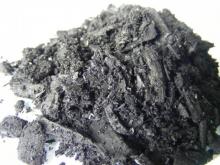Data provider
Budapest University of Technology and Economics, Department of Applied Biotechnology and Food Science, Environmental Microbiology and Biotechnology Group
Contact details
Biochar name and quantity
Feedstocks and additives
- Agricultural and forestry waste
- Grain, feedstuffs, fruit
Production technology
PYREG® pirolizáló berendezésben, fekete cseresznyéből, 600-700 °C -on előállított, 15 perc tartózkodási idő alatt.
Physical and chemical properties
Physical properties
Chemical properties
55% SZAT
Biological and ecotoxicological specifications
Aerob Heterotróf összsejtszám [CFU/g bioszén]: 4,934E+6E; Gombaszám [CFU/g bioszén]: 2,75E, Növénytesztek bekeverés nélkül: búzagyökér gátlási % homokra vonatkoztatva: 79%, búzaszár gátlási % homokra vonatkoztatva: 64%; mustárgyökér gátlási % homokra vonatkoztatva: -165%, mustárszár gátlási % homokra vonatkoztatva: 58%., Collembola teszt: Életben maradt Collembolák száma bioszénre téve (20db-ból)(db): 17; Növénytesztek 10%-ban bekeverve: búzagyökér gátlási % 10%-ban bekeverve, homokra vonatkoztatva: 6,4%, búzaszár gátlási % 10%-ban bekeverve, homokra vonatkoztatva: 25,3%, mustárgyökér gátlási % 10%-ban bekeverve, homokra vonatkoztatva: -15,1,5%, mustárszár gátlási % 10%-ban bekeverve, homokra vonatkoztatva: -2,1%,
Chemical content
- Metals, semi-metals and their compounds
- zinc
hordozható XRF
- Metals, semi-metals and their compounds
- copper
- Metals, semi-metals and their compounds
- iron
hordozható XRF
- Other inorganic chemical compounds
- calcium
hordozható XRF
- Other inorganic chemical compounds
- potassium
hordozható XRF
- Other inorganic chemical compounds
- sulphur
hordozható XRF
Potential utilisation in soil
homoktalajba keverve serkentheti (bizonyos esetekben) a növénynövekedést bár előkísérleteink alapján 10%-ban homoktalajba keverve enyhén serkentette vagy általában gátolta a növénynövekedést, míg bekeverés nélkül többnyire gátolta a növénynövekedést, bázikus kémhatása alkalmassá teszi savanyú talaj semlegesítésére.
K tartalmának köszönhetően
Ca, Fe és S tartalmának köszönhetően
Zn tartalmának köszönhetően
Bár az aerob heterotróf összsejtszáma nagy, ugyanakkor a Collembola teszt alapján nem bizonyult kockázatosnak, általában gátolta a növénynövekedést.
10%-ban homokos talajba keverve enyhén gátolta vagy csak enyhén gerjesztette a növénynövekedést.
szemcseméret függvényében
10%-ban homokos talajba keverve enyhén gátolta vagy csak enyhén gerjesztette a növénynövekedést.
10%-ban homokos talajba keverve enyhén gátolta vagy csak enyhén gerjesztette a növénynövekedést.
bázikus kémhatásának köszönhetően
talajra használat során előfordulhat toxikus hatás a talajökoszisztémára, amit ellenőrizni kell minden esetben és a talajba keverést ennek függvényében meghatározni.
